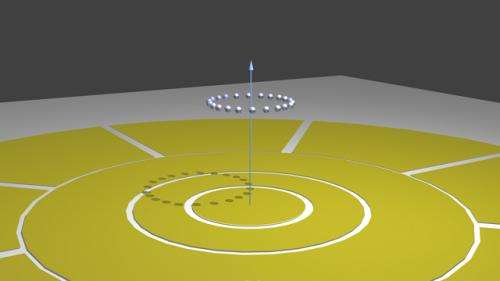May 3, 2013 report
Creating time crystals with a rotating ion ring

(Phys.org) —There has been a lot of talk recently about the possibility of building what has come to be known as a time crystal. In February 2012, Frank Wilczek originally proposed the idea that under certain conditions, physical structures can move in a repeating pattern without expending any energy. Last June, a group of researchers at Berkeley proposed a time crystal could be realized as a persistently rotating ring of charged atoms. Unfortunately a problem with that approach was pointed out by Patrick Bruno, who noted that to be a time crystal, an object must exhibit perpetual motion in its lowest energy state—the ground state. Commenting in Physical Review Letters in March, Bruno showed that the particular example described by Wilczek was actually one of a system in an excited state, and therefore not a time crystal. Taking advantage of recent breakthroughs in the construction of low noise ion traps, Berkeley researchers now plan to build an ion trap that will satisfy the critics.
The Berkeley team, led by Xiang Zhang and Hartmut Häffner, will attempt to build a time crystal by introducing 100 calcium ions into a 100-micron wide ion trap. The calcium ions will be confined by electric fields to form a crystalline ring, which will then be induced to rotate under the influence of a static magnetic field. According to the group's calculations, this ring should settle into the ground state when the atoms are pre-cooled with lasers to around one-billionth of a degree above absolute zero.
There are several different kinds of laser cooling, but the basic principle is to set up conditions where photons from the laser hit the atoms, and cause them to emit photons of a higher average energy than the one initially absorbed. The extra energy comes from the thermal excitations of the atoms (heat), and this energy is converted into the photon that leaves the atom. The lower bound on the temperature that could be obtained in this fashion had previously been limited by background heat emanating from impurities in the electrodes used in the trap. The new technique, which may now allow a time crystal to be made, involves cleaning the electrodes with an argon-ion beam that is integral to the trap. Experiments have shown that this cleaning permits up to 100-fold reduction electric-field noise in the trap.
The experimental plan is to properly cool the chamber and then apply the proper magnetic fields. At this point, the ions should begin to cycle around their starting point at regular intervals, forming the repeating lattice of the time crystal. To observe this ion rotation, one of the 100 calcium ions will then be toggled into a new electronic state using a laser. If the scientists observe that ion rotating at steady state, they will have in effect, "broken the translational symmetry of time."
Atoms within a crystal are said to break translational symmetry in space because they once confined by the discrete symmetry of the crystal, they are no longer free to take up any position along the spatial continuum. Wilczek got to thinking about the idea of a time crystal by imagining a system that would have time-periodic ground states that would break translational time symmetry. He previously considered both classical and quantum systems that are both spatially ordered, and move perpetually in the ground state in an oscillatory or rotational way.
The new Berkeley experiments to test these ideas may take a while to get underway. A few physicists, including Bruno, are still skeptical. His main objection is that it may not be possible to detect motion in the ground state. In other words, it may be feasible to set up the rotating ring of ions inside the trap, but not possible to ever observe it. It does not, however, appear that time crystals would violate any principle of thermodynamics. If they are ever made, potential applications could include ultra-precise clocks, or simulation of ground states in quantum computing schemes. It is probably too early to draw any definitive conclusions on building time crystals, and the new Berkeley experiment is probably not the last we will hear about.
More information:
Related publications:
physics.aps.org/articles/v5/116
prl.aps.org/abstract/PRL/v109/i16/e163001
prl.aps.org/abstract/PRL/v109/i10/e103001
via SimonsFoundation
Journal information: Physical Review Letters
© 2013 Phys.org


















